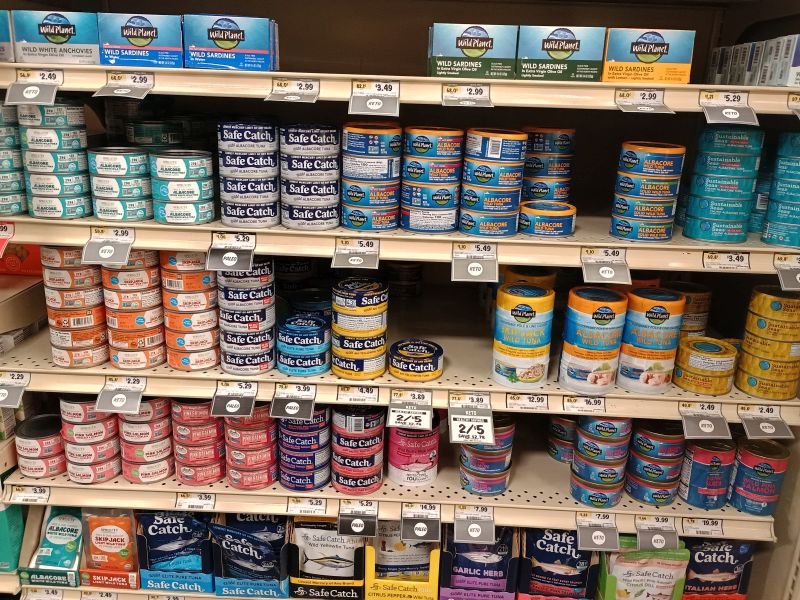The Lowdown on Tuna

I don't particularly enjoy fish but I do like canned tuna. It makes a quick nutritious meal and can be relatively cheap. But I never really gave the type of tuna I was buying much thought. It was just tuna, right? I knew there were different varieties but I didn't really know the differences between them. This was my tuna state of mind for a long time. But one day, as I was at the market pondering the selections, I started to come out of my tuna complacency and wondered what really was the difference between the varieties. And not only did I want to know what I was eating, I wanted to make sure it was sustainable. Turns out tuna is pretty interesting!

So, first a little background on tuna. You might think, like I used to, that tuna is tuna - just one specific fish. But no! There are all kinds of tuna and only some of them make it into cans or pouches. And, in addition to being delicious, tuna are pretty amazing! Check it out -
- Tuna are predatory, migratory saltwater fish
- There are 15 species of tuna
- The smallest (the bullet tuna) is 1.6 ft (50 cm) and 4 lb (1.8 kg)
- The largest (the Atlantic bluefin) is 15 ft (4.6 m) and 1508 lb (684 kg)
- One of only 3 species of fish that maintains a body temperature higher than the surrounding water
- One of the fastest swimming pelagic fish
Well, that's all pretty interesting but how does this help us figure out what's what in the tuna aisle at the market? Well, out of all those different types of tuna, only 5 of them are used commercially. Skipjack, albacore and yellowfin make up the majority of canned/pouched tuna while big eye and bluefin are primarily used for sushi/sashimi.

Of the species used for canned products, skipjack and yellowfin are classified as light meat and albacore is white meat. (2) In the US, albacore is the only tuna that can be sold with the label white tuna or white meat. (3) Skipjack and yellowfin have a more robust, fishy taste while albacore is very mild. Darker tuna tends to be flaky and tender while albacore is firmer and chunky. (4) This might make a difference depending on what you'll be making with the tuna. For a salad, you might want a chunkier tuna but if you want the tuna to incorporate into the dish a little better, then you might want to go for a flakier tuna.
Skipjack makes up 60% of the global annual tuna catch while albacore makes up 5%. Stocks of each are strong and sustainable. Most albacore is caught in the northern and southern Pacific. Only 10% of the global supply comes from the northern Atlantic where stock is not quite as robust and special conservation measures need to be taken. (3)
If you are concerned about mercury levels, skipjack has one of the lowest levels of all the commercial tuna. This is due to its small size. It's also one of the most sustainable because of its fast reproductive cycle. (4)
In addition to wanting my tuna to be sustainable, I also wanted it to be responsibly caught. There are several different fishing methods:
- Purse Seine -involves a huge net that can be up to 2000 meters in length and 250 meters deep. It indiscriminately catches everything.
- Longline - just like it sounds, a long main line which is run for miles behind a boat. There are shorter lines attached to the main line which have baited hooks. Species other than tuna can get caught on these lines.
- Surface Troll - boats use lures which trail along the surface of the water while the boat slowly moves. Caught fish are pulled off the lures by hand.
- Pole and Line - pretty much like it sounds, with fishermen using long poles and lines to catch individual fish.
Surface troll and pole and line are the 2 methods that affect other species the least, because the method is designed specifically to catch tuna.

So it looks like I found my answer! Skipjack tuna is the most sustainable and contains the least amount of mercury of all the types of tuna used for cans or pouches. I will also make sure to look on the can to see how it was caught. Although most skipjack is caught using the purse seine method (5), I buy the Wild Planet brand which is caught using either pole and line or surface trolling.
If you found any of this interesting and want to know more, all the sites I referenced are great but I'm especially impressed by the Canned-Tuna.com site. It has a wealth of information, including pictures of the various fishing methods, a nice rundown on the can contents and labeling and a history of canned tuna.




Want some more facts about tuna? Of course you do! How could you pass up the oppor-tuna-ty to learn more?